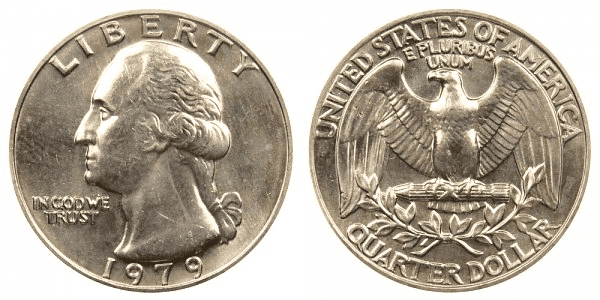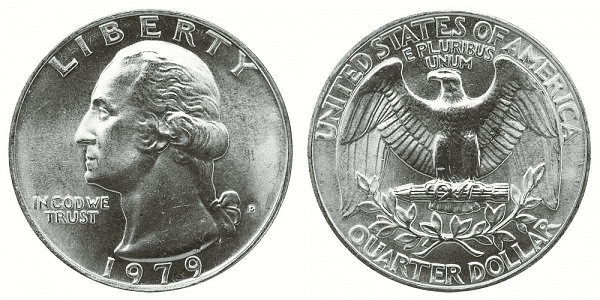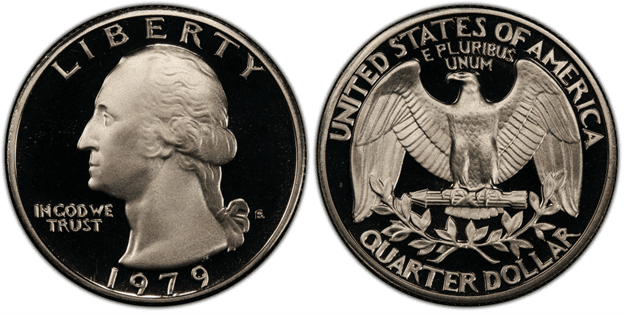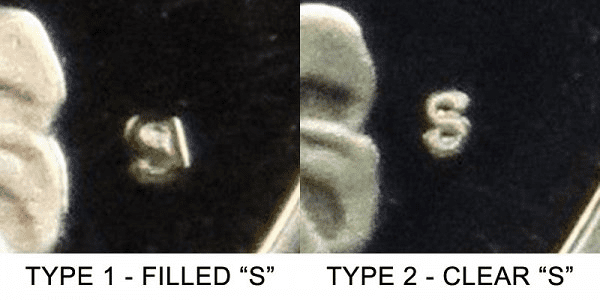What Is A 1979 Washington Quarter Made Of?
Starting in 1968, the Washington Quarters’ silver content was replaced by a 91.67% copper core and an 8.33% nickel coating. John Flanagan created the image of George Washington facing left on the coin’s obverse based on Jean-Antoine Houdon’s bust from 1786.
The word “LIBERTY” is engraved all the way around the coin’s obverse, covering Washington’s hair as well. The year “1979” is etched all the way around the bottom of the smaller George Washington bust.
To the left of Washington is written the country’s slogan, “IN GOD WE TRUST.”
An heraldic eagle in the style of Art Deco is perched on a group of arrows on the coin’s reverse. The arrows and the head of the eagle both point to the left.
The words “United States of America” are printed all the way around the top of the coin, while the base of the eagle is surrounded by two sprays of olive branches arranged in the form of a U.
Below it is the motto E PLURIBUS UNUM. On the coin’s base, the word “QUARTER DOLLAR” is printed. The edge of the 1979 Washington quarter is reeded.
Both the Three Mile Island nuclear disaster and Margaret Thatcher’s election occurred in 1979. Trivial Pursuit, the Sony Walkman, and Pink Floyd’s reknowned album “The Wall” were all released in this year as well.
How To Differentiate Between Clad And Silver 1979 Quarters?
It was planned for all 1979 quarters to be made of a clad material. In rare examples some quarters can be accidentally struck on silver planchets.
It is always worthwhile to investigate if your coin might be an extremely uncommon mistake example because these coins are extremely rare and valuable.
When it comes to weight, silver coins are heavier than copper coins. Silver quarters weigh 6.25 grammes, while clad quarters weigh 5.7 grammes, to use Washington quarters as an example.
On their exteriors, both have different ageing processes. While clad coins take on a copper hue with time, silver coins usually tarnish over time.
Two coins falling simultaneously generate two distinct sounds. Silver coins have a higher-pitched sound and ring to them than non-silver coins, which sound more like a dull thud.
1979 Quarter Varieties
1979 P Quarter (No Mint Mark)
Year: 1979
Face Value: $0.25
Composition: 91.67% Copper and 8.33% Nickel
Weight: 5.67g
Diameter: 24.3 mm
Thickness: 1.95 mm
Edge: Reeded
Minted in: Philadelphia
Mint Quantity: 518,708,000

1979 D Quarter
Year: 1979
Face Value: $0.25
Composition: 91.67% Copper and 8.33% Nickel
Weight: 5.67g
Diameter: 24.3 mm
Thickness: 1.95 mm
Edge: Reeded
Minted in: Denver
Mint Quantity: 489,789,780

1979 S Quarter
Year: 1979
Face Value: $0.25
Composition: 91.67% Copper and 8.33% Nickel
Weight: 5.67g
Diameter: 24.3 mm
Thickness: 1.95 mm
Edge: Reeded
Minted in: San Francisco
Mint Quantity: 3,677,175

Type 1 : Filled S/Type 2 : Clear S

There were two varieties of the 1979 S Proof Washington Quarter. One variety was the Type 1 Filled S, which is shown on the left side of the mint mark comparison image. This type’s mint mark was less distinct and somewhat filled in.
The second variety, Type 2 Clear S, is shown on the right side of the mint mark comparison image and featured a clearer and larger mintmark.
List of errors
Coins having mint flaws may be produced as a result of deliberate activities by mint workers, production problems, or deterioration in the minting equipment. Unexpectedly, mistake coins are typically worth more than their regular counterparts.
Like other coins, certain 1979 quarter pieces may contain mint blunders. However, the majority of 1979 quarters were produced flawlessly. Therefore, severe mistakes on coins from this series are rather uncommon.
The table below lists the most common coin mistake types from 1979:
| Error Coin | Value |
| 1979 Error Quarter Double Rim & Broad Strike | $90 |
| 1979 Washington Quarter Error Filled D | $150 |
| 1979 ‘D’ Triple Error Washington Quarter | $175 |
| 1979 Washington Quarter Mintmark Error: Double Filling on ‘D.’ | $180 |
How Much Is A 1979 Quarter Worth Today?
A 1977 quarter’s low $0.052 melt value illustrates that any value (above the face value) assigned to this money is based on factors like condition, defects, and provenance. Due to the absence of precious metal, this coin has no melt value.
The majority of the value of these coins, aside from rarities, is decided by their condition, with the exception of MS-grade coins, which are only worth their face value because they are still in circulation.
The values for a 1979 Quarter are as follows:
| Coin | Value |
| 1979-P Washington Quarter | 25 ¢–$6.65 |
| 1979-D Washington Quarter | 25 ¢–$6.65 |
| Type 1 1979-S Proof | $9.14 |
| Type 2 1979-S Proof | $11 |
How Does The Grading System Work?
The Sheldon Scale is used by numismatists to provide a numerical value to coins. The Sheldon Scale goes from poor (P-1) to perfect mint state (P-1) (MS-70). Coins were originally evaluated using words to reflect their condition (Good, Fair, Excellent, Etc.). Unfortunately, coin collectors and dealers had different ideas about what each of these terms represent.
Professional numismatists joined together in the 1970s and established CoinGrading standards. These numismatists now assign grades at key places on the seventy-point scale, using the most regularly utilized numeric points in conjunction with the original adjective grade. The following are the most common coin grades:
-
-
- (P-1) Poor – Indistinguishable and probably damaged; if used, must have a date and mintmark; otherwise, rather battered.
- (FR-2) Fair – Nearly smooth, but without the damage that a coin graded Poor often possesses. The coin must have enough detail to be identified.
- (G-4) Fair – Inscriptions have merged into the rims in some areas, and important elements have been mostly erased.
- (VG-8) Very Good- A little weathered, but all of the primary design elements are visible, albeit faintly. There is little if any, central detail left.
- (F-12) Good – The item is very worn, yet the wear is even, and the overall design details stand out clearly. Rims are almost completely isolated from the field.
- (VF-20) Very Fine – Moderately weathered, with some finer features still visible. The motto or all letters of LIBERTY are readable. Both sides of the coin have entire rims that are separated from the field.
- (EF-40) Extremely Fine – Gently used; all gadgets are visible, and the most important ones are bold. The finer details are bold and clear, however, light wear may be seen.
- (AU-50) Uncirculated – Slight evidence of wear on the coin’s design’s high points; may have contact marks; eye appeal should be adequate.
- (AU-58) Uncirculated Choice – Slight traces of wear, no severe contact marks, almost full mint shine, and great eye appeal.
- (MS-60) Mint State Basal – Strictly uncirculated; no indication of wear on the coin’s highest points, but an unsightly coin with reduced luster, visible contact marks, hairlines, and other flaws.
- (MS-63) Mint State Acceptable – Uncirculated, but with contact scratches and nicks, little reduced shine, but otherwise appealing appearance. The strike is weak to average.
- (MS-65) Mint State Choice – Uncirculated with great mint shine, very little contact blemishes, and exceptional eye appeal. The strike is unusually severe.
- (MS-68) Mint State Premium Quality – Uncirculated with superb luster, no obvious contact marks to the naked eye, and exceptional eye appeal. The strike is quick and appealing.
- (MS-69) Almost Perfect Mint State – Uncirculated with perfect brilliance, a sharp and appealing strike, and extremely good eye appeal. A near-perfect coin with minor imperfections in the planchet, strike, and contact markings (seen only under 8x magnification).
- (MS-70) Mint State Perfect – Under 8x magnification, there are no tiny imperfections discernible; the strike is crisp, and the coin is perfectly centered on a beautiful planchet. Rarely seen on a coin, this coin is bright and whole, with original luster and exceptional eye appeal.
-
Where To Buy Or Sell 1979 Quarters?
Before considering selling a 1979 quarter in your collection, it can be helpful to carefully examine it to look for any flaws or distinguishing characteristics.
Regular 1979 quarters can be bought or sold on online stores like Etsy and eBay for a few dollars and are prized for their novelty and nostalgic value.
You can post an image to a forum for coin collectors to ask for help if you’re hesitant but think you might have something unusual, there are even some great guides by the U.S. Mint.
By only transacting with trustworthy, specialised sellers like Heritage Auctions, you may avoid fraud when buying and selling rare 1979 quarters.
FAQs
Where is the mint mark on a 1979 quarter?
The Mint Mark on a 1979 Quarter is found on the obverse side of the coin to the right of Washington’s ponytail.
What is a rare error on a 1979 quarter?
One of the most sought-after error coins in the 1979 Washington Quarter Mintmark Error: Double Filling on ‘D’, which can be worth around $180.
Does a 1979 quarter have a mint mark?
Yes, unless minted by the Philadelphia Mint.
How much is a 1979 Canadian quarter worth?
1979 Canadian Quarters are worth around their face value.
